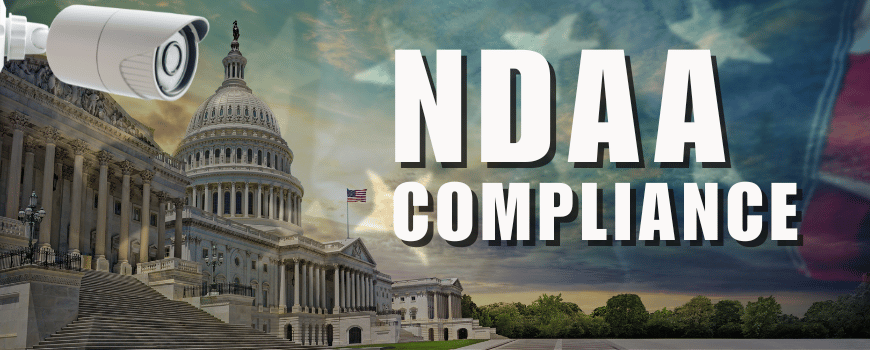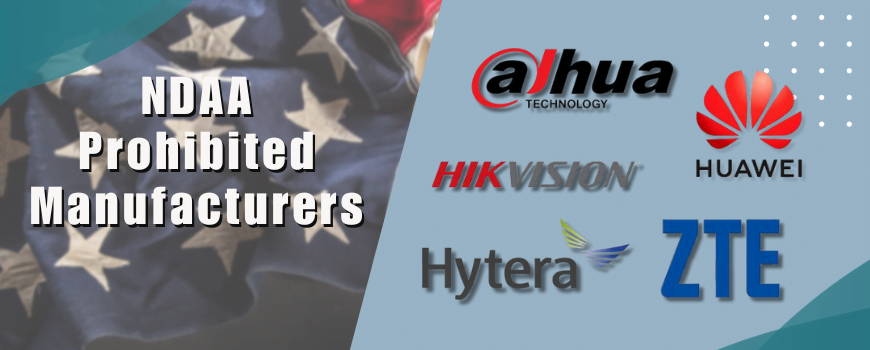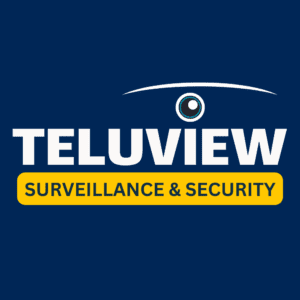
Navigating NDAA Compliant Video Security Solutions
What is NDAA Compliance?
Surveillance devices that align with the standards of the NDAA strictly follow the directives of the United States’ National Defense Authorization Act, legislation put in place for the protection of national security. These rules distinctly curtail the installation and use of surveillance and technological products from a list of producers considered a risk to national security. To be sanctioned for deployment on property managed by the U.S. government or on the domains of companies engaged with the U.S. federal government, such surveillance equipment must comply with the requirements of Section 889 from the 2019 NDAA.
How is NDAA Compliance Defined?
No components of the equipment can be sourced from a prohibited supplier. Even if a manufacturer is not specifically listed, if the manufacturer sources components from a company on the prohibited manufactures list, that equipment cannot be legally installed. 1“New law bans US gov’t from buying tech from Chinese giants ZTE and Huawei”. Ars Technica. Retrieved October 1, 2018
Component and equipment manufacturers that are prohibited include:
- Hikvision
- Huawei
- ZTE
- Hikvision
- Dahua
- Hytera
What is the NDAA, and why should security installers care about it?
NDAA - A Broad Act with Specific Implications
In simple terms, the National Defense Authorization Act comprises a series of federal laws passed annually by Congress to outline the budget for the U.S. Department of Defense. 2National Defense Authorization Act for Fiscal Year 2019, from GovInfo.gov
For those in the security sector, the act’s intricacies, especially within sections like “Other Matters,” hold substantial relevance, despite the dense legalese that might not be the most engaging material. Section 889 in this document, for instance, sets forth prohibitions on specific telecommunications and video surveillance services or equipment. The restrictions put in place by this section are not just for show; they have a real-world impact on the kinds of technology that security professionals can deploy, especially when it involves U.S. government properties or working with federal government contractors.
If you would like to read the whole act, click here.
To simplify, if you’re in the business of video surveillance, whether through services or equipment sales, the 2019 NDAA is something you can’t afford to overlook.
The specific paragraph in the 2019 NDAA that applies to security camera installers is…
The head of an executive agency may not— (A) procure or obtain or extend or renew a contract to procure or obtain any equipment, system, or service that uses covered telecommunications equipment or services as a substantial or essential component of any system, or as critical technology as part of any system; or (B) enter into a contract (or extend or renew a contract) with an entity that uses any equipment, system, or service that uses covered telecommunications equipment or services as a substantial or essential component of any system, or as critical technology as part of any system. (2)
Nothing in paragraph (1) shall be construed to— (A) prohibit the head of an executive agency from procuring with an entity to provide a service that connects to the facilities of a third-party, such as backhaul, roaming, or interconnection arrangements; or (B) cover telecommunications equipment that cannot route or redirect user data traffic or permit visibility into any user data or packets that such equipment transmits or otherwise handles.

What falls under the scope of this legislation? Which manufacturers are not NDAA Compliant?
NDAA Banned Equipment Manufacturers
The National Defense Authorization Act of 2019 casts a spotlight on the People’s Republic of China, marking it as the focus of heightened scrutiny. The act lays down explicit restrictions on a range of telecommunications and video surveillance equipment3“Rule Banning Chinese Telecommunications Equipment is Released”. Holland & Knight, July 2020, specifically:
- Telecommunications solutions crafted by Huawei Technologies Company and ZTE Corporation, or any of their branches.
- Video surveillance equipment from entities such as Hytera Communications Corporation, Hangzhou Hikvision Digital Technology Company, and Dahua Technology Company, as well as any of their affiliates.
Additionally, the legislation bars the utilization of telecommunications or video surveillance services from these mentioned firms or any group that integrates equipment manufactured by these entities.
NDAA Banned Equipment Types and Components
The regulations encompass two main bans. Firstly, telecommunications equipment from Huawei and ZTE is prohibited4Prohibition on Certain Chinese-origin Telecommunications Equipment or Services. Columbia Research, August 2020. Secondly, video surveillance equipment from Hytera, Hikvision, and Dahua falls under the ban5Prohibition on Certain Chinese-origin Telecommunications Equipment or Services. Columbia Research, August 2020. Given that video surveillance technology is considered telecommunications technology, any security camera or recorder with major components from these companies is unsuitable for federal government projects.
This broad-reaching embargo extends to any form of security tech—from cameras to recorders—that contains critical parts from the proscribed companies. It’s not uncommon for hardware from Hikvision, Dahua, or Hytera, even the microchips like Huawei’s HiSilicon SoC, to be repackaged or integrated within products under a different label, which are termed OEM or ‘white label’ products.
Therefore, vigilance is key. Companies and government entities alike are tasked with peeling back the layers to understand exactly what’s inside the equipment they plan to use. It’s not sufficient just to look at the brand; instead, you have to consider whether any piece, however small or seemingly insignificant, originates from the firms in question.
When it comes to ensuring compliance with the 2019 NDAA , it’s evident that meticulous research and verification of security equipment are paramount. The retrieved information points to alternatives such as Axis, UniView, and Samsung WiseNet, which are compliant options that meet federal requirements, due to the fact that they do not use any restricted components. Companies like TeluView can help make the process easier, by doing the research, and providing you with valuable information about whether a product is NDAA Compliant.
Which security cameras are permissible for use on US government properties?
Identifying NDAA Authorized Equipment
Due to the lack of transparency from most manufacturers regarding the components used in their equipment, determining if equipment is NDAA compliant can be challenging. Therefore, it’s vital that your supplier provides full transparency regarding the camera’s manufacturer and chip type.
TeluView offers NDAA compliant solutions from a selection of esteemed brands that align with these regulations. Let’s delve into the offerings that mark each brand’s commitment to adherence:
Uniview (UNV): Uniview has carved a niche for itself in the security sphere, showcasing its prowess at esteemed industry events such as Intersec Dubai. Their array of products, like the lauded UNV 4MP Deep Learning PTZ Camera that’s built to weather the elements with LightHunter technology and the sturdy UNV 4MP Easystar Bullet Camera, serve as stalwarts in NDAA-compliant surveillance.
Hanwha WiseNet: Born from the legacy of Samsung Hanwha Techwin, Hanwha WiseNet has emerged as a pillar of innovation and staunch reliability in the surveillance arena. Their range of products, from the sharp-eyed security cameras to comprehensive systems, meets the rigorous standards set forth by NDAA stipulations.
Vivotek: With a reputation for trust and a portfolio that meets the toughest of standards, Vivotek offers an arsenal of surveillance products that pass the NDAA muster with flying colors, ensuring users are equipped with top-notch, compliant technology.
The TeluView TLC Series: Dedication to exemplary service is the foundation of our promise to customers. This includes full transparency in regard to the components we have selected for our TeluView TLC Series of Cameras and Recorders.
TeluView’s NDAA Compliance Statement: TeluView requires all component manufactures of TeluView branded equipment be fully compliant with the requirements of the 2019 NDAA. TeluView also requires all manufacturers to provide a signed Declaration of NDAA Compliance for all currently available components, and all future components as required.
NDAA Compliance In Conclusion
TeluView Can Help You Meet NDAA Requirements
TeluView understands the challenges faced by customers who need to install video surveillance equipment on government properties. With numerous security cameras available, some manufactured or containing components from banned companies, determining which products are suitable for federal government use can be daunting. Many companies withhold this critical information, adding to the complexity of the 2019 NDAA requirements.
While we prioritize transparency and reliability in our products at TeluView, trust is not built overnight. We aim to foster trust through consistent integrity, offering accurate information and effective tools to support your business growth.
Our commitment extends beyond selling security cameras; we aspire to be your trusted partner in advancing the security industry.
Additional Resources
- https://researchmemos.ucop.edu/index.php/site/memoDetail/memo_id/RPAC-20-05.
- https://www.nytimes.com/2020/02/19/business/huawei-us-court.html
- https://www.federalregister.gov/documents/2020/07/14/2020-15293/federal-acquisition-regulation-prohibition-on-contracting-with-entities-using-certain
- If you would like to read the complete 2019 NDAA, click here.
Did you Know TeluView Has an Ebay Store?
Find coupons and sales exclusive to our Ebay Store!
